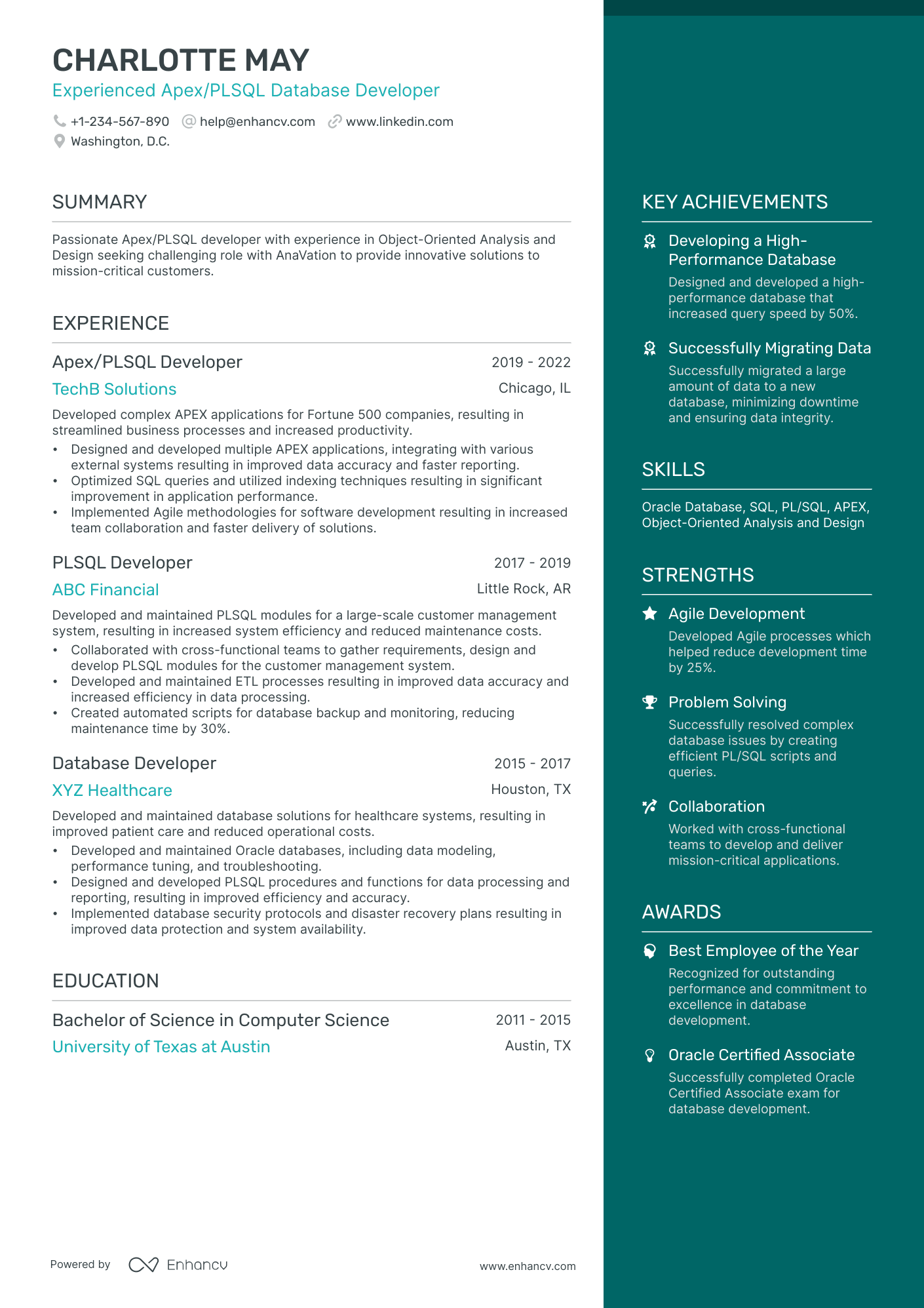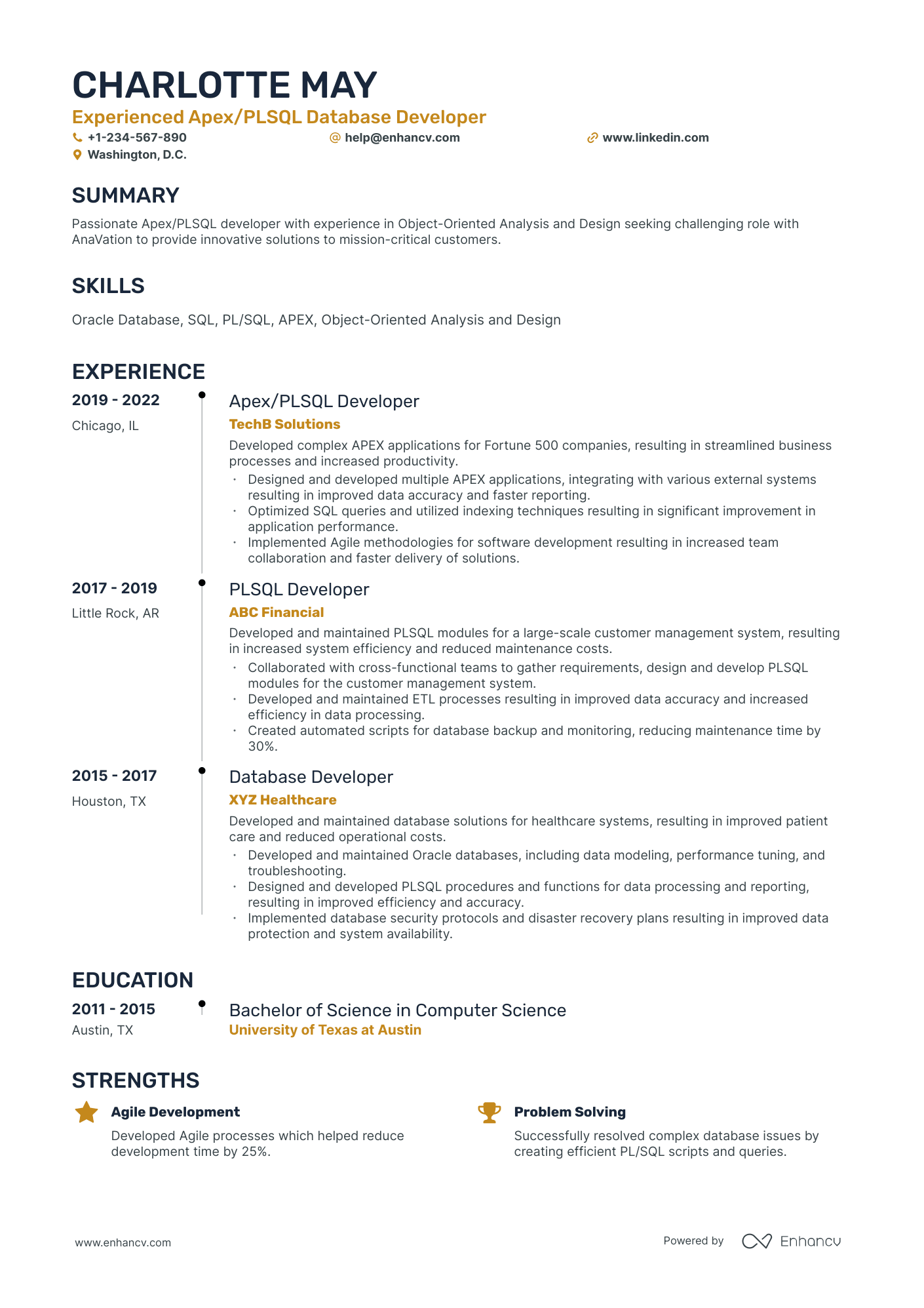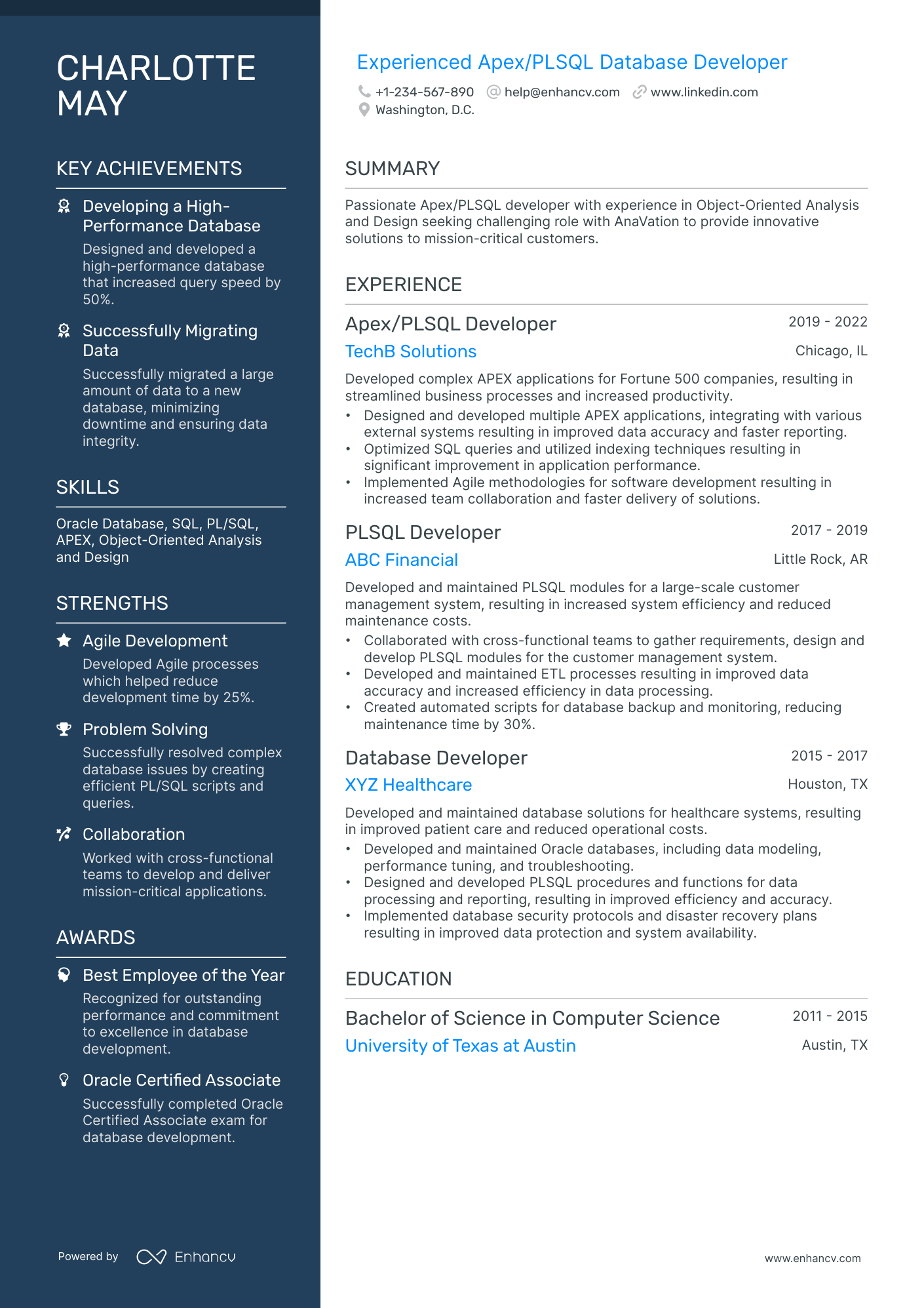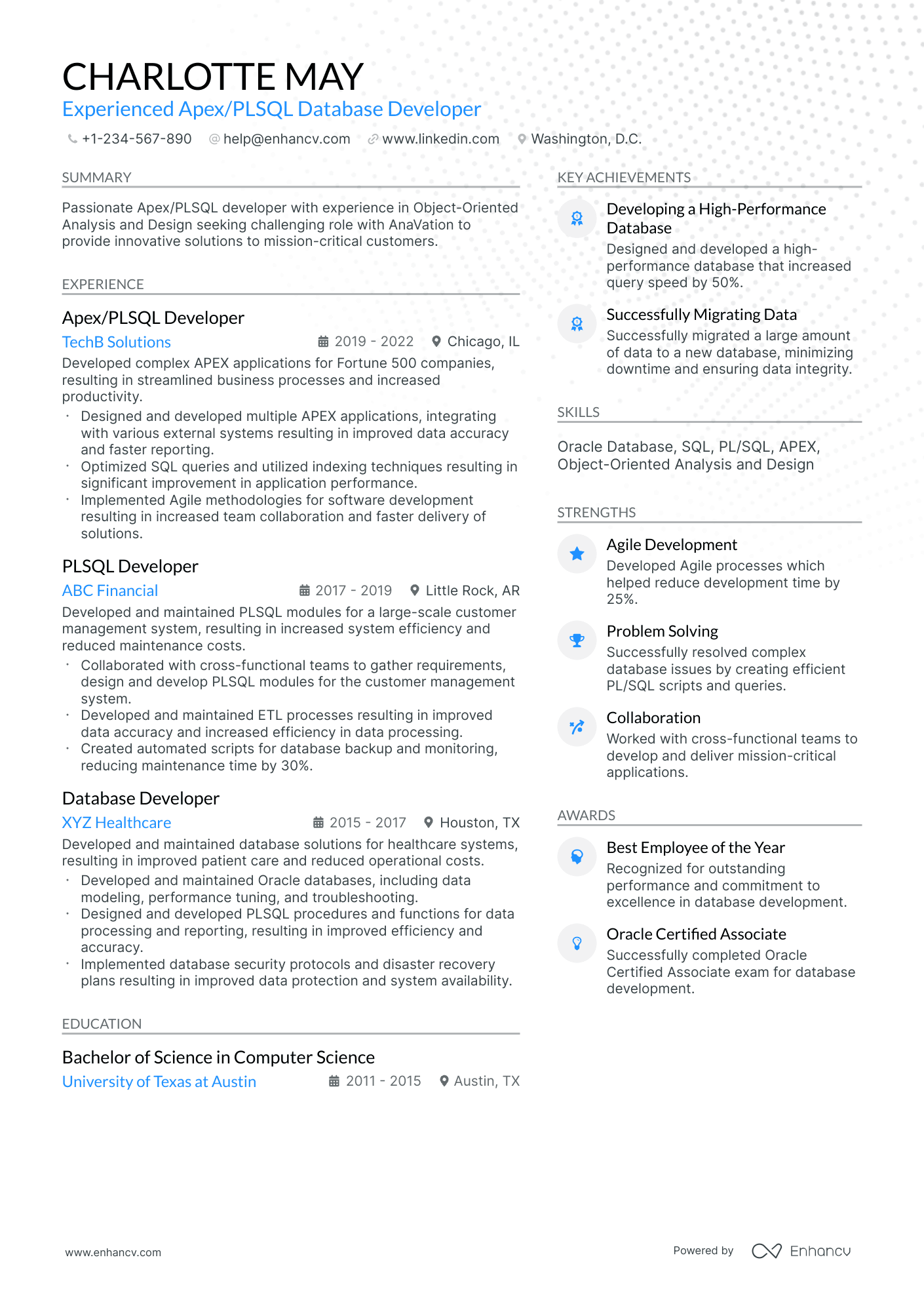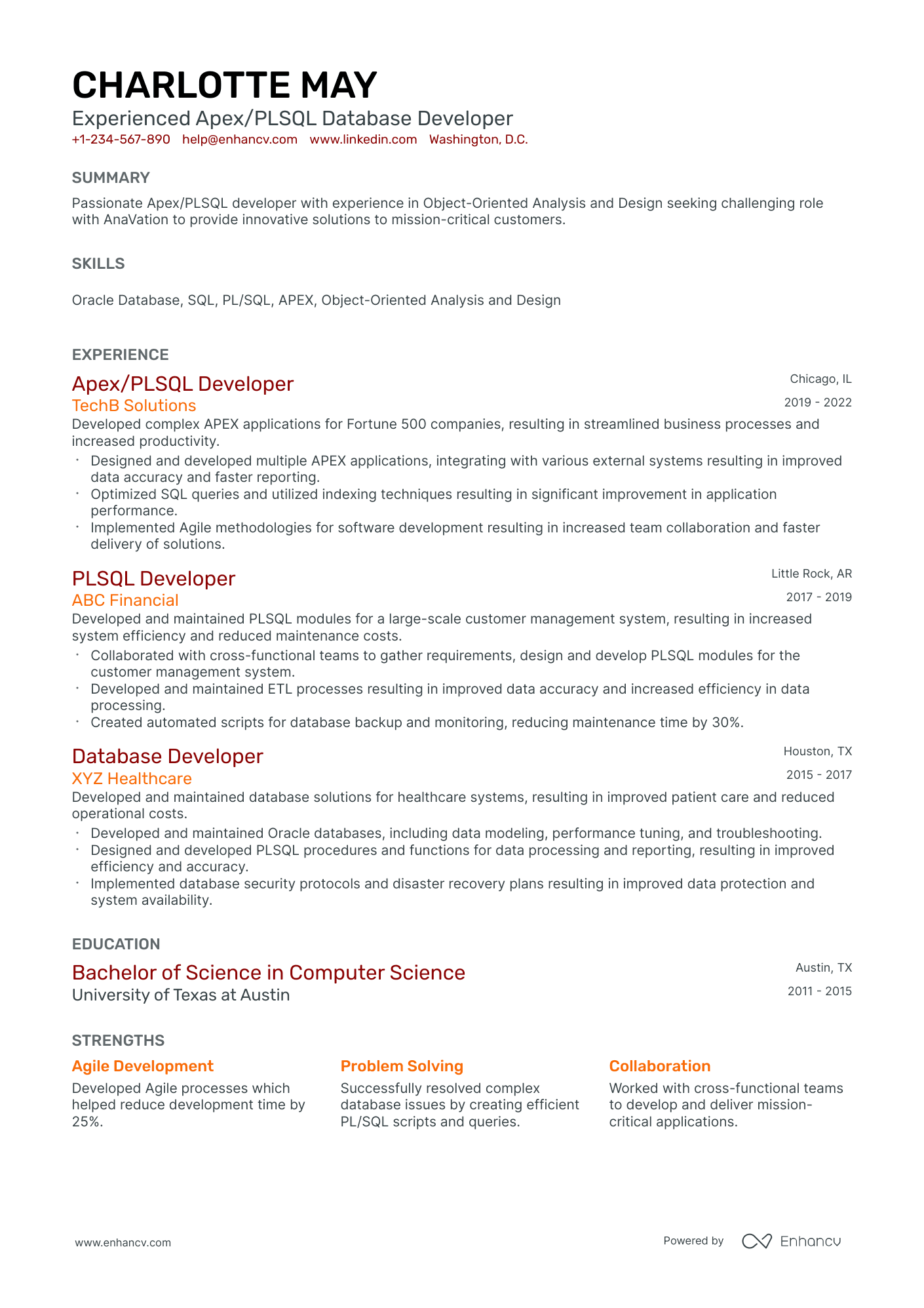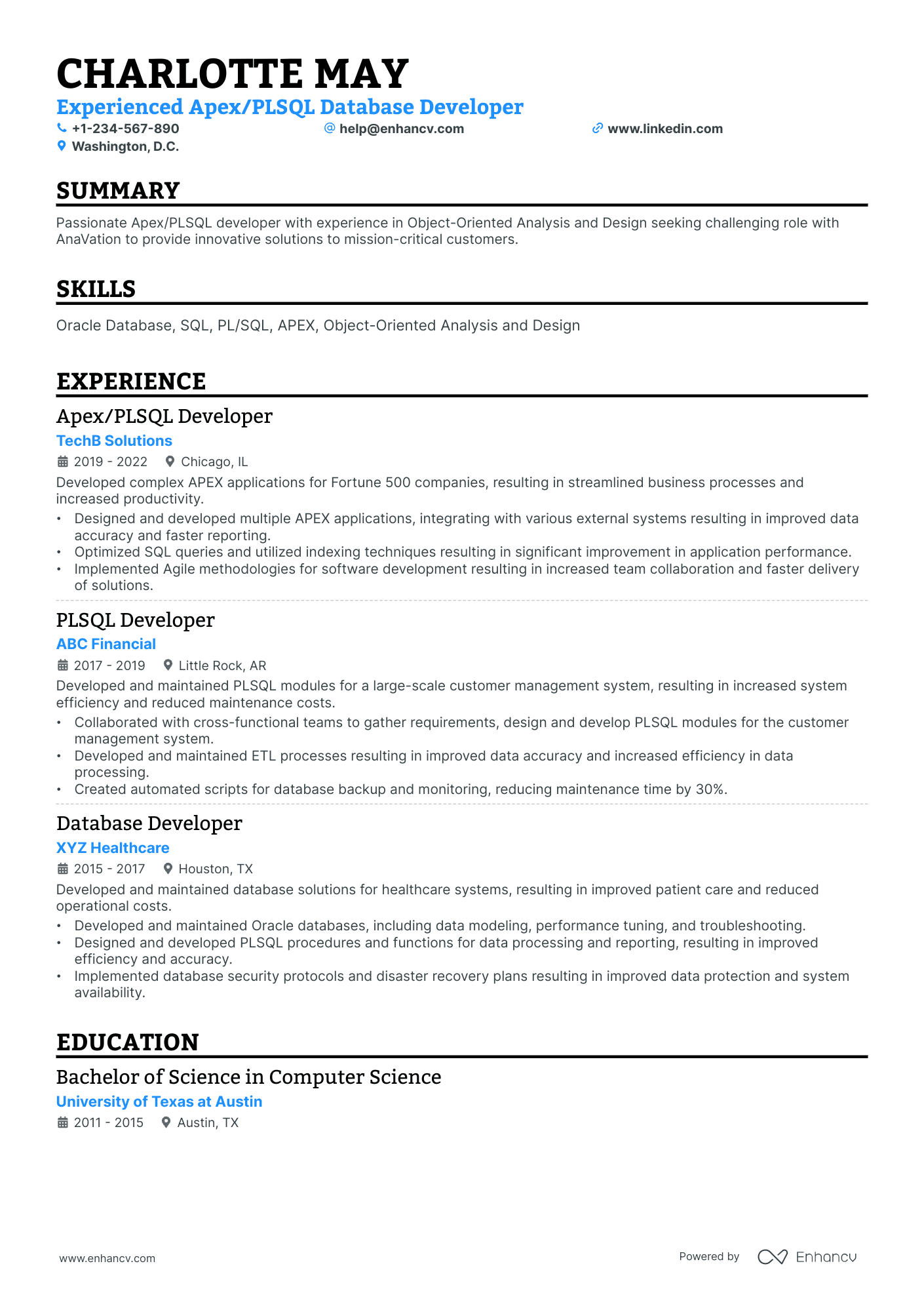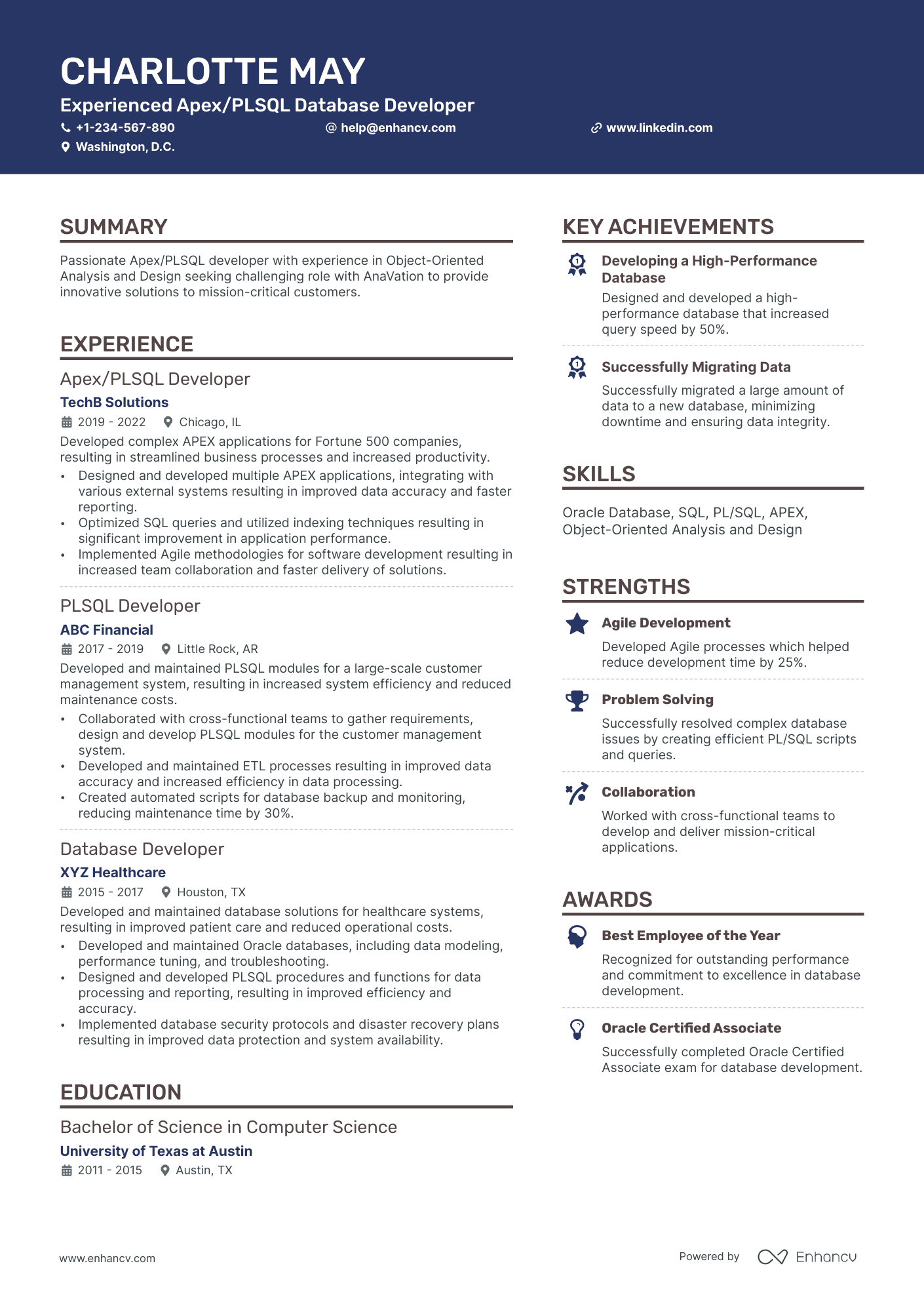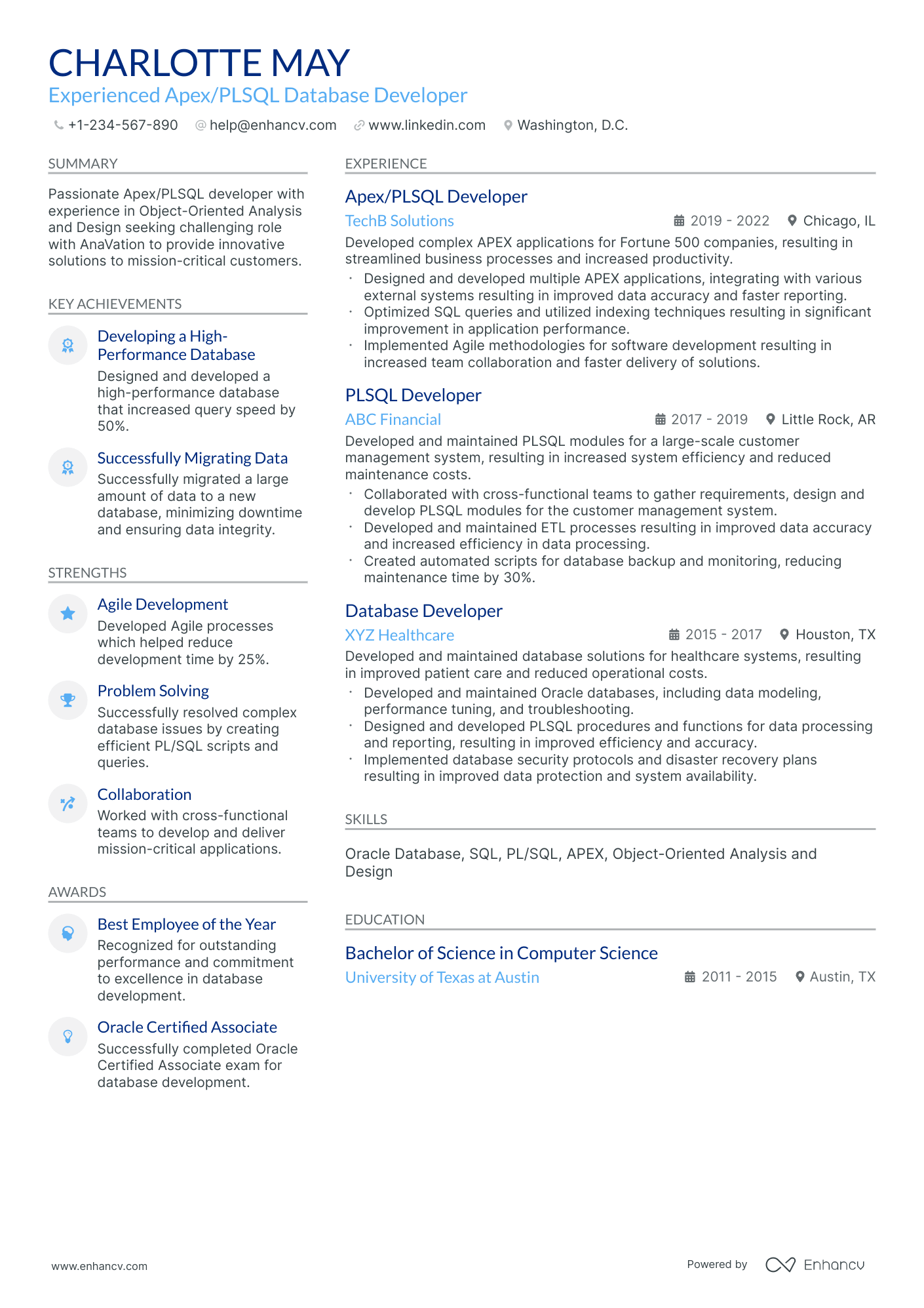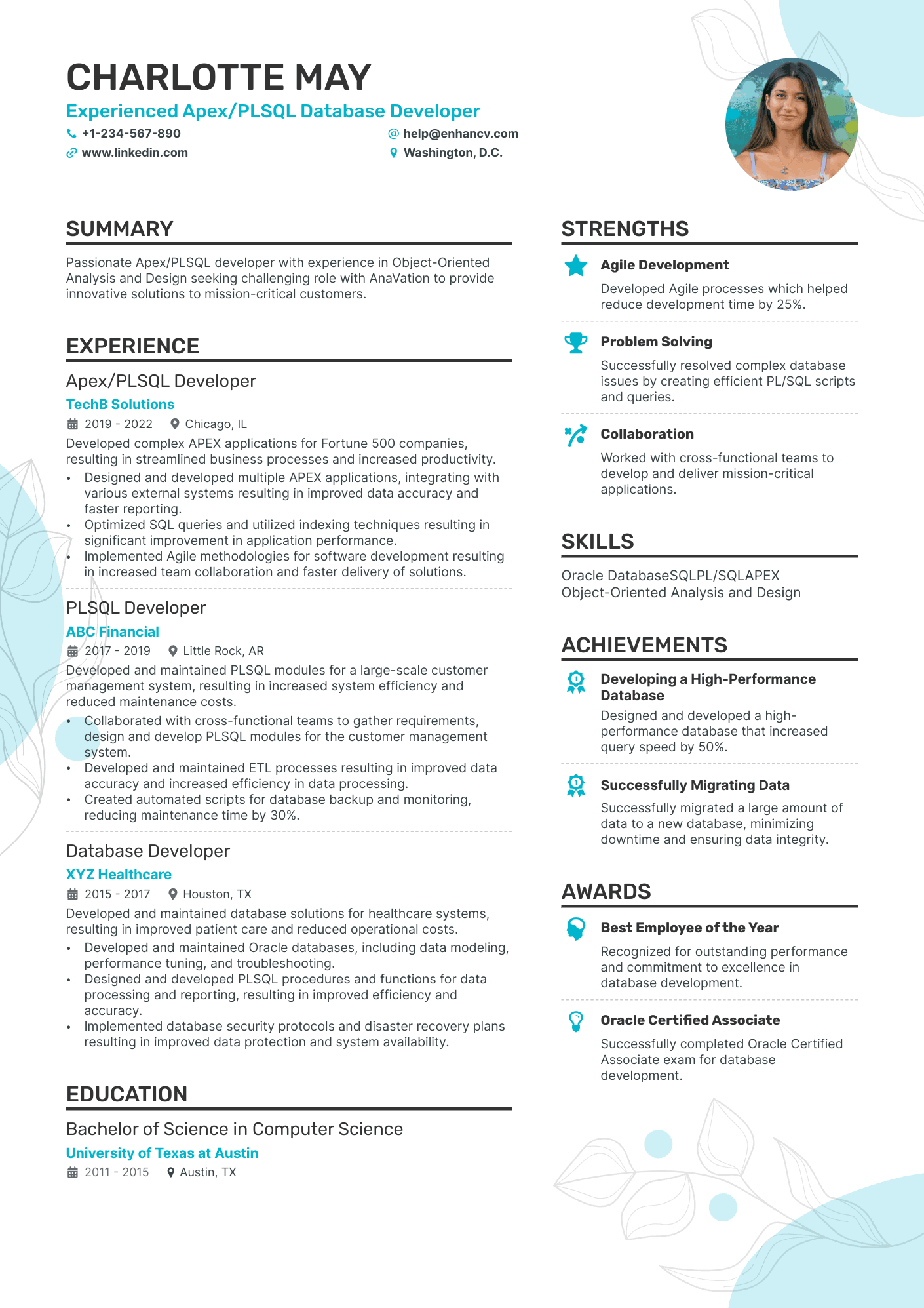It’s an excellent time to be a developer seeking work in the industry. The US Bureau of Labor Statistics’ Occupational Outlook Handbook says, “Overall employment of database administrators and architects is projected to grow 8 percent from 2022 to 2032, faster than the average for all occupations.”
Despite the growing demand, an updated resume will be critical in landing a new role, even if you’re an experienced database developer. Rapid tech changes and increased use of Applicant Tracking Systems (ATS) mean an up-to-date, well-written resume is the best way to gain the attention of hiring companies.
Whether you’re new to development or an experienced database developer, following this guide, including expert tips and examples, will help you understand how to:
- Format your resume for increased ATS optimization.
- Select, organize, and showcase your most valuable hard and soft skills.
- Quantify your skills in your resume experience, education, certifications, and portfolio sections.
- Choose between and write either a summary or objectives section.
- Implement keyword strategies to ensure your resume gets reviewed by hiring companies.
- Incorporate notable projects and work samples in a database developer portfolio.
To dive deeper into the resume-building topics covered here, follow up with these related resume guides:
- Node Js Developer Resume Examples
- .Net Full Stack Developer Resume Examples
- Senior Developer Resume Examples
- Blockchain Developer Resume Examples
- SAP Abap Developer Resume Examples
Database developer resume example
Here's what this applicant does well in their resume:
- Highlighting project achievements: The applicant effectively showcases specific achievements in past projects, such as developing complex APEX applications for Fortune 500 companies and improving system efficiency in healthcare systems. Demonstrating their impact in previous roles.
- Certification and education: Including the Oracle Certified Associate certification and a Bachelor of Science in Computer Science prominently on the resume adds credibility to their technical skills, which is vital for a role in database development.
- Quantifying success: The applicant has quantified their successes, such as reducing development time by 25% and increasing query speed by 50%. Making their achievements more tangible and impressive to potential employers.
How to format a database developer resume
Formatting plays an increasingly crucial role in database developer resumes as more employers are utilizing Applicant Tracking Systems (ATS) to parse information from resumes. These systems analyze and sort resumes for review by employers. Prioritizing resumes that explicitly include desirable skills and qualifications.
Understanding the impact formatting has on ATS analyses improves your resume's chances of being viewed by an employer.
To format your database developer resume for improved ATS analysis, consider the following:
- Creative elements: Including creative elements, such as colors, patterns, or a header photo, makes your resume unique and memorable. However, the use of some creative elements within text, such as emojis and non-standard date formats, can impede an ATS’ ability to recognize the text. Therefore, standard formatting is vital within the text sections of your resume.
- Font selection: Select ATS-friendly fonts that match the overall theme of your resume. Examples of ATS-friendly fonts are Serif and Sans-serif, Aria, and Times New Roman. However, these can also be boring or generic since they are commonly used. For more creative options available on the Enhancv Resume Builder, try Rubik, Lato, Montserrat, Raleway, Exo 2, and Volkhov.
- Header content: Include a prominent header featuring your name, desired job title, and contact information (phone number and email address) to ensure the information is easily readible.
- Section headings and sSubheadings: Ensure all resume sections are logically organized and include clear, accurate headings.
- Ordering: When listing any items, always use reverse chronological order, putting your most recent and relevant examples at the top.
- Document type: Doc or PDF files are standard for resumes and most easily analyzed by ATSs.
ATS-optimized formatting of your resume sections ensures accurate information recognition. Include the following top-recommended sections for database developer resumes.
Different regions expect different formats – Canadian resumes, for example, may look unique.
Is your resume good enough?
Drop your resume here or choose a file. PDF & DOCX only. Max 2MB file size.
The top sections on a database developer resume:
- Professional summary: Provides a brief overview of your database development expertise and achievements.
- Technical skills: Highlights specific database technologies and programming languages you are proficient in.
- Work experience: Details your past roles and contributions as a database developer.
- Education and certifications: Lists relevant degrees, certifications, and training in database development.
- Database projects: Showcases specific projects or contributions to databases, reflecting practical skills.
As you format your resume sections, you should begin thinking about which skills you can refer to in each section. Use the list below to be certain you include your most in-demand database development skills.
What recruiters want to see on your resume:
- Proficiency in SQL and database management systems: Essential for building and maintaining efficient databases.
- Experience with data modeling and architecture: Critical for designing databases that meet business requirements.
- Knowledge of database security practices: Important to protect sensitive data and comply with regulations.
- Problem-solving skills: Valuable for troubleshooting and optimizing database performance.
- Understanding of data warehousing and ETL processes: Key for managing large data sets and ensuring data integrity.
How to write your database developer resume experience
The experience section details your relevant work history. Employers use this section to determine how closely past jobs align with their position and to better understand your career progression.
A common mistake among developers is listing their entire work history, regardless of its relevance to the available position. However, a lengthy experience list requires ATS and employers to sift through and discern the relevance themselves. A cursory scan could lead employers to incorrectly assume your previous work doesn’t align with the vacancy.
To address this, create a targeted experience section by only including jobs that demonstrate knowledge abilities outlined in the job description. Allowing employers to recognize relevant experiences at a glance.
PRO TIP
To easily target your database developer resume for each new application:
- Create a resume template that includes all your experiences and skills.
- Make a copy of the template each time you apply for a position.
- In the new document, delete all irrelevant experience examples.
- Edit the remaining examples to include keywords from the job description.
When determining relevance, remember database management requires current knowledge of industry technology that is constantly developing and changing. Therefore, old experience examples that include outdated skills or expertise are considered irrelevant.
To better understand how to target an experience section, compare the current relevance of these experiences examples.
- •Learned about various IT roles and responsibilities and assisted in providing technical support to employees.
This example shouldn’t be included on a database developer’s resume. Although experience in an IT role may be relevant, and this was likely a prestigious internship, it was completed 23 years ago for a now-defunct communications company. Additionally, no direct database tools or skills are mentioned in the description.
- •Full software development cycle role working in an Agile development environment.
This example would be an excellent addition to a resume. The experience is recent and in a database development role. Additionally, the phrases “full software development cycle” and “Agile development environment” are likely keyword phrases directly from the description of the desired position.
How to quantify the impact on your resume
Including quantifiable evidence means including measurable or tangible items as proof of your skills and knowledge.
For example, stating that you have experience in database performance optimization is less effective than sharing a query optimization project that improved retrieval speed by 20%.
While numbers and statistics are an excellent way to quantify skill, you may not always have access to necessary data. Luckily there are many ways to evidence your skills and knowledge on your resume:
- Be specific: Name specific technology stack used in past positions, including languages, libraries, and frameworks, for example, R, Django, or MongoDB, as evidence of your proficiency with them.
- Give descriptions: Describe the size or complexity of databases you’ve worked with to illustrate your ability to handle large or complex databases.
- Note significant projects: Include examples of large, complex, or challenging projects you’ve successfully undertaken. Such as projects involving database migration, security upgrade implementation, or database performance optimization. Collaborative projects also highlight your ability to work cross-functionally.
- Add certifications: Include certifications and training you’ve completed to reinforce your stated proficiency.
- Credit your creations: Refer to custom SQL queries or stored procedures you have written as examples of your ability to create tailored solutions to problems.
By incorporating these strategies, your resume becomes a showcase of your skills and provides potential employers with a clear understanding of your qualifications and achievements.
How do I write a database developer resume with no experience
Writing a resume with no prior database developer experience can be intimidating. But, due to the increasing demand for database developers, employers are now more open to considering resumes with related experiences that show the potential for success in database development development.
Follow these steps to write your experience sections without previous database development experience:
- Compile a list of keywords from the job description.
- Brainstorm previous experiences in your non-developer career, educational background, or personal life that showcase the key skills and knowledge from your list of keywords.
- Include non-development experiences exhibiting transferable skills.
- Include quantifiable evidence, such as certifications, to add credibility.
Remember that a lack of work experience in the field of database management doesn’t mean you don’t already have sufficient skills and knowledge needed for success. Some employers even prefer candidates who are new to the field for their unique, fresh perspective.
Pro tip
For those with no database development work experience, your database developer Cover letter is an excellent opportunity to offer further detail and describe how skills and knowledge acquired outside the field are transferable to database development.
How to list your hard skills and soft skills on your resume
When listing skills on your database developer resume skills section, including hard and soft skills is essential. Since hard skills tend to be the focus for database developers, neglecting to mention soft skills altogether is common.
Hard skills are those required to perform a particular job. They typically require study, training, and practice. In database development, these skills are related to management systems, languages, platforms, tools, specializations, and other technical aspects.
Best hard skills for your database developer resume
- SQL programming
- Database design and modeling
- MySQL, PostgreSQL, or Oracle
- NoSQL databases (e.g., MongoDB, Cassandra)
- Data warehousing technologies
- ETL (Extract, Transform, Load) processes
- Database performance tuning and optimization
- Stored procedures and triggers
- Database security measures and protocols
- Backup and recovery strategies
- Cloud database services (e.g., AWS RDS, Azure SQL Database)
- Microsoft SQL Server
- PL/SQL or T-SQL
- Data migration tools and techniques
- Reporting and query tools (e.g., Crystal Reports, SSRS)
- Version control systems (e.g., Git)
- Linux/Unix operating systems
- Big data technologies (e.g., Hadoop, Spark)
- Python or R for data manipulation
- Business Intelligence (BI) tools (e.g., Tableau, Power BI)
Soft skills are your intrinsic, personal skills related to work. These skills are transferable from one field to another because they are part of an employee’s personality or identity. For example, some database developers have an eye for detail, while others can easily visualize big-picture concepts.
Best soft skills for your database developer resume
- Problem-solving skills
- Attention to detail
- Effective communication
- Team collaboration
- Time management
- Adaptability to new technologies
- Critical thinking
- Organizational skills
- Project management
- Customer service orientation
- Analytical thinking
- Decision-making
- Resilience under pressure
- Creativity in problem-solving
- Self-motivation
- Emotional intelligence
- Continuous learning
- Leadership potential
- Negotiation skills
- Cultural awareness
Follow these steps to write your database developer skills section:
- Format your skills section as a simple list without elaboration or examples.
- Organize long skill lists into subsections such as “Sever Management Skills” and “Data Science Skills.”
- Include hard and soft skills and differentiate between them by listing them separately.
- Target your list for individual positions by including key skills from the job description.
- Write your key skills exactly as they are in the job description to enhance ATS optimization.
- Never lie about or exaggerate your skills.
- Check that your experience section and skills section are consistent. Include all skills mentioned in your experience section in the skills section, and reference your skills in your experience descriptions.
An employer may be looking for a database developer proficient in MySQL and receive numerous resumes from qualified applicants. However, a candidate who mentions they’re an analytical thinker with a knack for problem-solving may stand out as the best fit for the position.
Presenting relevant hard and soft skills on your resume gives employers a more holistic idea of who you are and what you’ll contribute to their business.
How to list your certifications and education on your resume
Degrees and certifications verify the hard skills on your resume. Additionally, they quantify soft skills like dedication to “continued learning” and “adaptability to new technologies.”
When adding these sections to your resume, format them as separate sections, “Certifications” and “Education.”
To write your database developer education section, follow these steps:
- List degrees in reverse chronological order to ensure your most recent and relevant degree is first on the lists.
- Include the name of the university, its’ location, and the title of your degree. Including your GPA is optional unless a specific GPA minimum is specified in the job description.
- Only include your major and minor if relevant to the position or provide relevant information about your background. For example, a minor in Language Technologies may be relevant to positions. However, a minor in Theater isn’t.
To write your database developer certifications section, follow these steps:
- Limit certifications to current, unexpired credentials.
- Include the name of the certification, the certifying institution, and the year obtained. The year is significant for tech-related certificates since substantial changes or updates may have occurred since it was obtained.
- Limit your certifications to only those specifically mentioned or related to skills from the job description. For example, if applying for a position in SQL Programming, don’t include your MongoDB Associate Developer Certification.
If you’re looking to add a database developer certification to your resume. Consider one of the following frequently sought by employers seeking database developers.
Best certifications for your database developer resume
- Microsoft DP-300 Exam: Administering Relational Databases On Microsoft Azure
- Google Cloud’s Professional Data Engineer
- MongoDB Database Administrator
- Meta Database Engineer Professional Certificate
- Oracle Certified Professional, Oracle Database 19c: Data Guard Administrator Certification
How to write your database developer resume summary or objective
Resumes are primarily lists of data and facts. The summary or objective section allows you to contextualize this information. Regardless of which section you choose, the goal is to briefly explain your suitability for a job.
The main difference between a summary and an objective section is what part of your career is the focus. The past or the future. A summary contextualizes past experiences, while an objective explains career goals you hope to accomplish.
A summary is preferable for database developers with extensive experience in similar roles to the available position. A summary highlights how your background indicates suitability and potential success.
To write a database developer resume summary, follow these best practices:
- Highlight your most relevant skill or experience that directly overlaps with the new role.
- Write an impactful description using keywords directly from the job description.
- Be brief. A summary should be between 3-5 sentences.
Check out the following example of how to improve a database developer summary by including relevant keywords.
This summary is too vague and provides little insight into past experience, skills, or future goals. Its lack of specifics results in missed opportunities to include keywords, hard and soft skills, and quantitative evidence of skills and experience.
This summary demonstrates how the inclusion of specifics improves the overall quality. This summary names soft skills such as “results-drive” and hard skills by naming database technologies in which they have proficiency. Using specific keywords would improve ATS optimization and clearly demonstrate skills aligned to a particular position.
Candidates with little or no experience won’t want to focus on their lack of direct experience in database development, but on what they hope to accomplish with the skills and background they do have. Therefore, an objective section is better suited to this goal.
To write your database developer resume objective, follow these best practices:
- Describe the kind of position you are seeking.
- Describe relevant transferable or soft skills you hope to use in database development.
- Highlight your motivation to learn and gain experience.
- Use keywords directly from the job description.
- Be brief. Keep your objective to 3-5 sentences.
The following examples demonstrate how a shift in focus can improve a resume objective.
This objective focuses too much on the applicant’s lack of experience and what they hope to gain from the position. Although they have relevant skills for a job in database programming, they seem to have little idea of how they would use them in the field. Moreover, rather than focusing on contributions they can make to the company, they focus on what they hope to gain from the experience.
This objective focuses only on how their background will contribute to their success in database development without citing their lack of experience in the particular role.
While these personal statements are brief, they should be packed with detail. Enabling employers to better understand the overall trajectory or state of your career without needing to make assumptions based on the information listed in your resume.
Optimize your resume summary and objective for ATS
Drop your resume here or choose a file.
PDF & DOCX only. Max 2MB file size.
Additional sections for a database developer resume
If you have additional, relevant skills or experiences that don’t fit among the top resume sections of your database developer resume, and you’d like to include them, consider one of these additional, optional resume sections.
- Languages: A languages section is highly relevant in database development. Today’s workforce is increasingly global. Therefore, fluency in more than one language can be a valuable asset that sets you apart from other applicants.
- Programming languages: The ability to program in various languages such as SQL, Python, and R is a skill many employers will value. Be sure to distinguish between spoken and programming languages by listing them in separate sections.
- Awards and achievements: Notable awards and achievements are an effective way to demonstrate the quality of your work. Listing awards such as project competition recognition or GitHub awards is a great way to distinguish yourself from other applicants. Be sure those you list are relevant, recognizable, and verifiable.
- Publications: Sharing publications is a way to establish you aren’t just knowledgeable, you’re an expert in your field. Publications may be written by others referring to your work or self-written material featured in a reputable publication. Some examples would be research papers, case studies, articles published on highly-regarded online platforms, and contributions to books on development. Again, however, limit these to the most recognizable, noteworthy, and relevant.
- Professional associations: A professional Associations section highlights your dedication to ongoing improvement and staying current in your field. If you’re interested in adding a professional association to your resume, consider joining one of the top professional associations for database developers listed below.
Professional associations for database developers
- Data Management Association
- Association for Computing Machinery (ACM)
- Association of Information Technology Professionals (AITP)
- CompTIA
- Association of Software Professionals (ASP)
Selecting specialized resume sections ensures your resume reflects all your highest qualifications. It’s also a great way to distinguish you from other applicants. If you decide to include a section not named on this list, be sure they use catchy headings and are ATS-friendly.
How to include a database developer portfolio section in your resume
A Portfolio section is a way to showcase significant projects or impressive code samples on your resume. Database developer portfolios provide short descriptions of relevant projects or code samples with links to repositories.
Portfolios can be especially useful for applicants with limited work experience since they can include school or personal projects that may not fit into other resume sections. It is also an excellent way to quantify hard skills.
Here’s how to include a portfolio section on your database developer resume:
- Create a portfolio section heading.
- Include only projects that showcase skills required for the position as described in the job post.
- Organize Projects with the most relevant or significant featured first.
- Title each project with a short, straightforward title.
- Provide a URL or link to repositories such as GitHub or Bitbucket.
- Give a brief 1-2 sentence description of the project, including keywords from the job description.
A portfolio section can be an excellent way to demonstrate skills and experience. However, only include high-quality work samples relevant to the position you are applying for. Additionally, ensure you have the proper permissions before sharing information about proprietary or work-related projects and repositories before including them.
Key takeaways
Remember, once you’ve created a strong database developer resume, it is vital to regularly update it to ensure it reflects your current industry tech skills and tailor it to individual jobs. Review these key takeaways to be sure your resume stands out to potential employers.
- ATS-optimized formatting is vital to ensure your resume gets reviewed by employers.
- Target your database development skills and experience by including information relevant to the specific position.
- Provide tangible evidence of your skills and achievements to quantify skills and impact in previous roles.
- List both hard and soft skills, carefully considering the relevance and precise wording for enhanced ATS optimization.
- List relevant education and certifications in reverse chronological order to highlight up-to-date knowledge.
- Include a summary or objective section to provide context for the information listed on the resume.
- Add a portfolio section to showcase hard skills.

